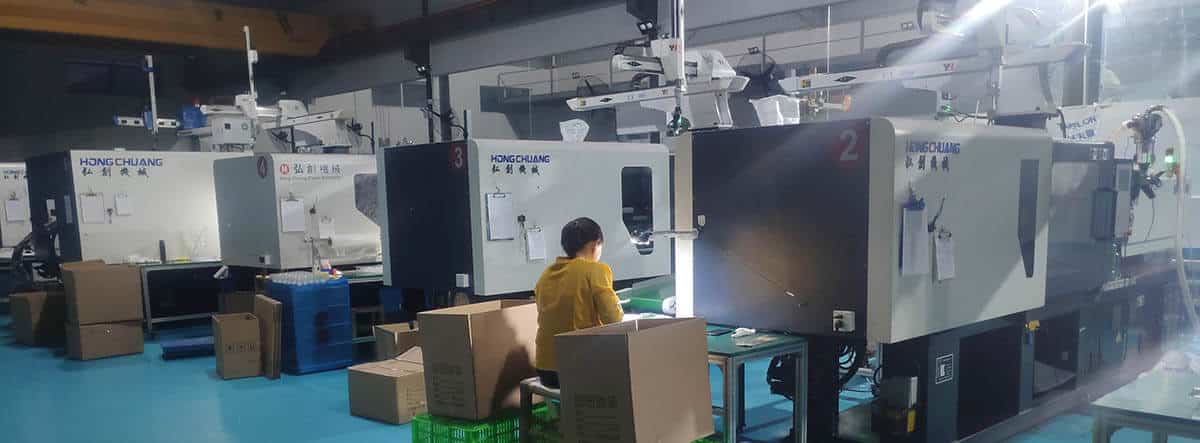Safety aspects at injection molding plant

Good Housekeeping in the Molding Shop
Generally, there would not be many accidents at the molding shop if all aspects of good housekeeping were strictly observed. However, in the pursuit of production, good housekeeping is often neglected, sometimes with disastrous consequences.
Oil Spillage
Spills of granules and leakages of oil are common in the mold shop. Granules, oil, and water can often combine, creating hazardous conditions.
- Hazardous Conditions: Oil spillage can remain on the floor for hours or even days, posing serious risks. A single cigarette end or spark can ignite a fire.
- Absorption Methods: While rags and sawdust are often thought to absorb oil, they are ineffective. Proprietary materials are better for soaking up oil safely.
- Cleaning Protocol: In case of an oil spill, it’s crucial to clean up immediately with a proper detergent solution to ensure safety.
Flexible Pipes and Leads
Flexible wires and connections draped across machine perimeters can create safety hazards.
- Potential Risks: Forklifts or cranes can damage these pipes and wires, leading to severe accidents.
- Proper Arrangement: All flexible leads should be clipped neatly into position to prevent tripping hazards.
- Color-Coding: Use distinctive markings to easily identify auxiliary connections to machines.
Machine Guards
Machine guards are essential for protecting operators from hot plastic sprays.
- Material Selection: Guards made from sturdy, transparent materials like Perspex or polycarbonate are recommended.
- Regular Checks: Ensure that flexible connections to molds are not being abraded during operation.
- Protection Against Hazards: A protective sheet can help reduce the risk of fractured leads.
Disposing of Purgings and Hot Material
Hot and purging materials should never be left on machines to prevent burns and injuries.
- Heat Retention: Plastics retain heat for a long time; proper disposal methods are crucial.
- Toxicity Awareness: Decomposing acetal releases formaldehyde, which can be harmful in large doses.
Ventilation
Good ventilation is vital for maintaining a safe working environment.
- Airflow Management: Ensure adequate airflow through windows, doors, and extractor fans.
- Toxicity Precautions: Some plastics may release harmful additives; proper ventilation systems are essential.
Lighting
Proper lighting is crucial for safety in the molding shop.
- Regular Maintenance: Clean lamps and replace broken ones promptly to ensure visibility.
- Safety Standards: Follow lighting standards as outlined in factory legislation.
Safety Glasses
Operators must wear safety glasses, especially when working with granulating machines.
Lifting Tackle
Regular inspections of lifting equipment are necessary for safety.
- Weight Capacity: Clearly mark containers and molds with their maximum load capacity.
- Proper Equipment: Always use appropriate lifting gear; makeshift slings are not recommended.
Ladders and Scaffolds
Ensure ladders and scaffolds are sturdy and durable to prevent accidents.
- Secure Setup: Long ladders should be securely fastened, and two people should always be present when using them.
- Non-Skid Surfaces: Provide non-skid surfaces for bridges over pipes and troughs.
Airlines
Regularly inspect airlines and filters to prevent accidents.
- Water Traps: Bleed water traps and replace filters as needed.
- Safety Practices: Never use air hoses to blow dust off clothing, as this can cause serious injuries.
Fire-Fighting Equipment
Ensure fire-fighting equipment is accessible and properly maintained.
- Sprinkler Systems: Consider installing sprinkler systems to protect against fires.
- Strategic Locations: Keep static water tanks or fire buckets available at all times.
Noise
Minimize noise levels in the molding shop to protect employee health.
- Machine Maintenance: Replace panels during maintenance to reduce noise.
- Noise Barriers: Use dense blockboard screens to create a quieter working environment.
First-Aid Equipment
Provide appropriate first-aid equipment to treat minor accidents before they escalate.
- Regular Maintenance: Ensure first-aid supplies are maintained and easily accessible.
- Dust Removal: A dust-removal bottle is useful for addressing eye injuries.
Conclusion
If things are well-kept in the plant, then the chances of being hurt will Lower and overall work output will also increase. By utilizing sound spill protocols, using flexible piping to securely protect, putting in place reliable machine guards, and ensuring that there is sufficient ventilation and light in the working area, you can go a long way toward reducing this risk Regular maintenance or lifting equipment, using personal safety gear that fits properly with the existing hardware on site, and proper control of sound levels also help to make for much safer workplace environments.
What is more By giving attention to these basic regulations of housekeeping not only protects the employee but Is a precondition for greater efficiency and harmony in all work circles. Sticking to these guidelines will result in improved operational performance and a safer workplace for all.
